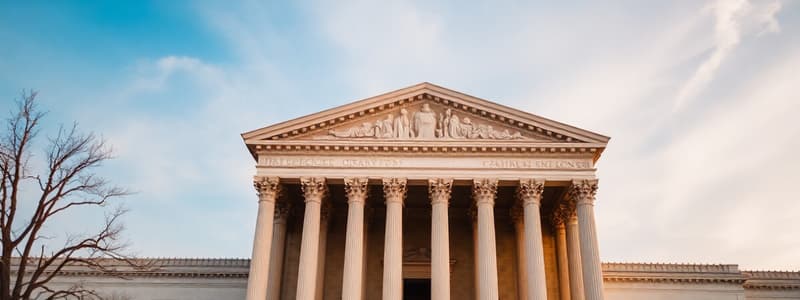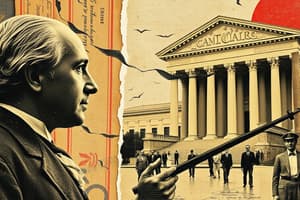Podcast
Questions and Answers
Which of the following scenarios best exemplifies the 'Rule of 4' within the Supreme Court's operations?
Which of the following scenarios best exemplifies the 'Rule of 4' within the Supreme Court's operations?
- A lower court decision is automatically overturned if at least four Supreme Court justices disagree with it.
- Oral arguments are limited to four hours, with each side receiving two hours to present their case.
- A law is deemed unconstitutional only if at least four justices vote in favor of striking it down.
- The Supreme Court agrees to hear a case only if at least four justices vote to grant a writ of certiorari. (correct)
In the context of the U.S. Supreme Court, what is the significance of the concept of judicial review as established in Marbury v. Madison?
In the context of the U.S. Supreme Court, what is the significance of the concept of judicial review as established in Marbury v. Madison?
- It allows the Supreme Court to overturn decisions made by lower federal courts.
- It enables the Supreme Court to interpret treaties between the United States and foreign governments.
- It grants the Supreme Court the authority to mediate disputes between the executive and legislative branches.
- It empowers the Supreme Court to declare laws unconstitutional, thereby checking the power of Congress and the President. (correct)
Which of the following actions represents a check on the power of the Supreme Court?
Which of the following actions represents a check on the power of the Supreme Court?
- Congress' ability to alter the size and jurisdiction of the Supreme Court. (correct)
- The Supreme Court's ability to nominate federal judges.
- The Senate's power to introduce legislation.
- The President's power to pardon individuals convicted of federal crimes.
Justice Scalia's textualist approach to interpreting the law emphasizes which of the following?
Justice Scalia's textualist approach to interpreting the law emphasizes which of the following?
An 'Amicus Curiae' brief is submitted to the Supreme Court to do what?
An 'Amicus Curiae' brief is submitted to the Supreme Court to do what?
Flashcards
Writ of Certiorari
Writ of Certiorari
An order by the Supreme Court directing a lower court to send up the records of a case for review.
Rule of Four
Rule of Four
A Supreme Court practice where at least four justices must agree to hear a case before it is granted certiorari.
Judicial Review
Judicial Review
The power of the Supreme Court to declare laws and actions of the other branches of government unconstitutional.
Textualism
Textualism
Signup and view all the flashcards
Amicus Curiae
Amicus Curiae
Signup and view all the flashcards
Study Notes
- Reaching the Supreme Court requires a writ of certiorari.
- Rule of 4: Four justices must agree to hear a case.
- The most important power of the U.S. Supreme Court is Judicial Review.
- Adams vs. Jefferson: Adams won.
- Adams was a federalist and Jefferson was a Democratic-Republican.
- Federalists created new courts to try influence over time before their power was diminished.
- Adams appointed a bunch of judges that are Federalists.
- Madison does not deliver Marbury's commission, so Marbury sues.
- The case Marbury sues is Marbuy vs Madison.
- John Marshall heard the case of Marbury vs Madison.
- John Marshall was a genius of the Supreme Court.
- He sides with the Democratic Republicans without endorsing what they are doing.
- John Marshall first established the concept of judicial review.
- Checks on the Supreme Court include a lack of congressional override.
- Congress can change the law, and Congress can change the Court.
- The Court can only react, but has positive power through "court curbing".
- The Executive can perform non-enforcement.
- John Marshall made his decision and now has to let someone enforce it.
The judiciary: Decisions
- Scalia vs. Breyer
- Scalia is not an originalist or textualist.
- Scalia looks at the actual text of the law when making decisions.
- Scalia asks "how are everyday Americans supposed to follow the law if we have to know more than what the law says?"
- Breyer focuses on the spirit of the law.
- Scalia has two problems: what's a reasonable legislator and if the judge decides what is reasonable, it is not a real democracy.
- Breyer uses context.
- Breyer says "Sometimes reading the text exactly is going to lead to bad decisions."
Steps to Supreme Court Decisions
- Step 1: Writ of certiorari steps assign writing decisions
- Step 2: Background
- Read briefs: amicus curiae ("friend of the court")
- Step 3: Oral arguments
- Step 4: Voting
Factors for the Court to Consider
- Stare decisis is a factor for the court to consider.
- The Supreme Court is going to keep the same law unless there is a good reason to change it.
- Amicus curiae, case history, and political factors are also taken into consideration.
Studying That Suits You
Use AI to generate personalized quizzes and flashcards to suit your learning preferences.
Description
The Supreme Court requires a writ of certiorari. The most important power of the U.S. Supreme Court is Judicial Review, first established in Marbury vs Madison. Checks on the Supreme Court include a lack of congressional override.




